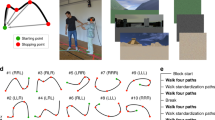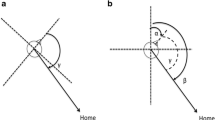Abstract
Path integration is fundamental to human navigation. When a navigator leaves home on a complex outbound path, they are able to keep track of their approximate position and orientation and return to their starting location on a direct homebound path. However, there are several sources of error during path integration. Previous research has focused almost exclusively on encoding error—the error in registering the outbound path in memory. Here, we also consider execution error—the error in the response, such as turning and walking a homebound trajectory. In two experiments conducted in ambulatory virtual environments, we examined the contribution of execution error to the rotational component of path integration using angle reproduction tasks. In the reproduction tasks, participants rotated once and then rotated again to face the original direction, either reproducing the initial turn or turning through the supplementary angle. One outstanding difficulty in disentangling encoding and execution error during a typical angle reproduction task is that as the encoding angle increases, so does the required response angle. In Experiment 1, we dissociated these two variables by asking participants to report each encoding angle using two different responses: by turning to walk on a path parallel to the initial facing direction in the same (reproduction) or opposite (supplementary angle) direction. In Experiment 2, participants reported the encoding angle by turning both rightward and leftward onto a path parallel to the initial facing direction, over a larger range of angles. The results suggest that execution error, not encoding error, is the predominant source of error in angular path integration. These findings also imply that the path integrator uses an intrinsic (action-scaled) rather than an extrinsic (objective) metric.






Similar content being viewed by others
References
Arthur JC, Philbeck JW, Kleene NJ, Chichka D (2012) The role of spatial memory and frames of reference in the precision of angular path integration. Acta Psychol 141:112–121
Bakker NH, Werkhoven PJ, Passenier PO (1999) The effects of proprioceptive and visual feedback on geographical orientation in virtual environments. Presence Teleoper Virtual Environ 8(1):36–53
Bakker NH, Werkhoven PJ, Passenier PO (2001) Calibrating visual path integration in VEs. Presence Teleoper Virtual Environ 10(2):216–224
Batschelet E (1981) Circular statistics in biology. Academic Press, London
Becker W, Jürgens R, Boss T (2000) Vestibular perception of self-rotation in different postures: a comparison between sitting and standing subjects. Exp Brain Res 131:468–476
Benhamou S, Séguinot V (1995) How to find one’s way in the labyrinth of path integration models. J Theor Biol 174:463–466
Berthoz A, Israël I, George-Francois P, Grasso R, Tsuzuku T (1995) Spatial memory of body linear displacement: what is being stored? Science 269:95–98
Chance SS, Gaunet F, Beall AC, Loomis JM (1998) Locomotion mode affects the updating of objects encountered during travel: The contribution of vestibular and proprioceptive inputs to path integration. Presence Teleoper Virtual Environ 7(2):168–178
Chrastil ER, Warren WH (2013) Active and passive spatial learning in human navigation: acquisition of survey knowledge. J Exp Psychol Learn Memory Cognit 39:1520–1537
Chrastil, E. R., Warren, W. H. (2014). Does the human odometer use an extrinsic or intrinsic metric? Attent Percept Psychophys 76(1), 230–246.
Fujita N, Klatzky RL, Loomis JM, Golledge RG (1993) The encoding-error model of pathway completion without vision. Geograph Anal 25(4):295–314
Glasauer S, Schneider E, Grasso R, Ivanenko YP (2007) Space-time relativity in self-motion reproduction. J Neurophysiol 97:451–461
Israel I, Berthoz A (1989) Contribution of the otoliths to the calculation of linear displacement. J Neurophysiol 62(1):247–263
Israel I, Sievering D, Koenig E (1995) Self-rotation estimate about the vertical axis. Acta Otolaryngol 115:3–8
Israel I, Bronstein AM, Kanayama R, Faldon M, Gresty MA (1996) Visual and vestibular factors influencing vestibular “navigation”. Exp Brain Res 112:411–419
Israel I, Grasso R, Georges-Francois P, Tsuzuku T, Berthoz A (1997) Spatial memory and path integration studied by self-driven passive linear displacement. I. basic properties. J Neurophysiol 77(6):3180–3192
Israël I, Warren WH (2005) Vestibular, proprioceptive, and visual influences on the perception of orientation and self-motion in humans. In: Wiener SI, Taube JS (eds) Head direction cells and the neural mechanisms of spatial orientation. MIT Press, Cambridge, pp 347–381
Ivanenko Y, Grasso R, Israel I, Berthoz A (1997) Spatial orientation in humans: perception of angular whole-body displacements in two-dimensional trajectories. Exp Brain Res 117:419–427
Jürgens R, Nasios G, Becker W (2003) Vestibular, optokinetic, and cognitive contribution to the guidance of passive self-rotation toward instructed targets. Exp Brain Res 151:90–107
Kearns MJ, Warren WH, Duchon AP, Tarr MJ (2002) Path integration from optic flow and body senses in a homing task. Perception 31(3):349–374
Klatzky RL, Loomis JM, Golledge RG, Cicinelli JG, Doherty S, Pellegrino JW (1990) Acquisition of route and survey knowledge in the absence of vision. J Mot Behav 22(1):19–43
Klatzky RL, Loomis JM, Golledge RG (1997) Encoding spatial representations through nonvisually guided locomotion: Tests of human path integration. Psychol Learn Motiv 37:41–84
Klatzky RL, Beall AC, Loomis JM, Golledge RG, Philbeck JW (1999) Human navigation ability: tests of the encoding-error model of path integration. Spatial Cognit Comput 1:31–65
Loomis JM, da Silva JA, Fujita N, Fukusima SS (1992) Visual space perception and visually directed action. J Exp Psychol Hum Percept Perform 18(4):906–921
Loomis JM, Klatzky RL, Golledge RG, Cicinelli JG, Pellegrino JW, Fry PA (1993) Nonvisual navigation by blind and sighted: Assessment of path integration ability. J Exp Psychol Gen 122(1):73–91
Marlinsky VV (1999) Vestibular and vestibulo-proprioceptive perception of motion in the horizontal plane in blindfolded man—II. Estimations of rotations about the earth-vertical axis. Neuroscience 90(2):395–401
Metcalfe T, Gresty MA (1992) Self-controlled reorienting movements in response to rotational displacements in normal subjects and patients with labyrinthine disease. Ann N Y Acad Sci 656:695–698
Mohler BJ, Creem-Regehr SH, Thompson WB (2006) The influence of feedback on egocentric distance judgments in real and virtual environments. In: Proceedings of the 3rd symposium on applied perception in graphics and visualization, ACM, pp 9–14
Müller M, Wehner R (1988) Path integration in desert ants, cataglyphis fortis. Proc Natl Acad Sci 85:5287–5290
Peruch P, May M, Wartenberg F (1997) Homing in virtual environments: Effects of field of view and path layout. Perception 26:301–311
Riecke BE, van Veen, H. A. H. C., Bülthoff HH (2002) Visual homing is possible without landmarks: a path integration study in virtual reality. Presence Teleoper Virtual Environ 11(5):443–473
Sadalla EK, Montello DR (1989) Remembering changes in direction. Environ Behav 21(3):346–363
Siegler I (2000) Idiosyncratic orientation strategies influence self-controlled whole-body rotations in the dark. Cognit Brain Res 9:205–207
Siegler I, Viaud-Delmon I, Israel I, Berthoz A (2000) Self-motion perception during a sequence of whole-body rotations in darkness. Exp Brain Res 134:66–73
Thomson JA (1983) Is continuous visual monitoring necessary in visually guided locomotion? J Exp Psychol Hum Percept Perform 9(3):427–443
Vidal M, Bülthoff HH (2010) Storing upright turns: How visual and vestibular cues interact during the encoding and recalling process. Exp Brain Res 200:37–49
Wang RF (2016) Building a cognitive map by assembling multiple path integration systems. Psychonom Bull Rev 23(3):692–702
Zhao M, Warren WH (2015a) How you get there from here: interaction of visual landmarks and path integration in human navigation. Psychol Sci 26:915–924
Zhao M, Warren WH (2015b) Environmental stability modulates the role of path integration in human navigation. Cognition 142:96–109
Acknowledgements
Preparation of this manuscript was supported by National Science Foundation awards BCS-0214383 and BCS-0843940, and by the National Aeronautics and Space Administration/Rhode Island Space Grant Consortium. The authors would also like the thank Henry Harrison, Joost de Nijs, and members of the VENLab for assistance with conducting this experiment.
Author information
Authors and Affiliations
Corresponding author
Rights and permissions
About this article
Cite this article
Chrastil, E.R., Warren, W.H. Rotational error in path integration: encoding and execution errors in angle reproduction. Exp Brain Res 235, 1885–1897 (2017). https://doi.org/10.1007/s00221-017-4910-y
Received:
Accepted:
Published:
Issue Date:
DOI: https://doi.org/10.1007/s00221-017-4910-y




